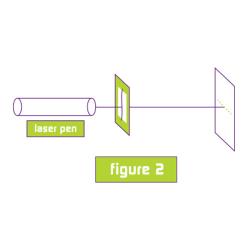Source Institutions
Source Institutions
Add to list Go to activity
Activity link broken? See if it's at the internet archive

This activity (on page 2 of the PDF under SciGirls Activity: Forensics) is a full inquiry investigation into how hairs from a crime scene are matched to suspects. Learners each take a single hair from their own head, then put it directly into the beam of a laser pointer. This projects the unique pattern of each hair onto a piece of paper to be traced, measured, identified and compared with the others. Learners can conclude this activity by setting up a mystery exercise with prepared samples of hair already in frames. Relates to linked video, DragonflyTV: Forensics.
- 10 to 30 minutes
- 1 to 2 hours
- Over $20 per group of students
- Ages 8 - 14
- Activity, Experiment/Lab Activity, Simulation
- English
Quick Guide
Materials List (per group of students)
- a laser pen and laser safety goggles
- stiff construction paper or a Manila folder
- white office paper
- scissors
- cellophane or masking tape
- a marking pen
- a meter stick or standard carpenter’s tape measure
- a centimeter ruler
- a dimly lit room
- a notebook
Subjects
-
Engineering and Technology
-
Technology
- Medical Technology
-
Technology
-
Life Sciences
-
Cells
- Cell Structure and Function
-
Heredity and Genetics
- Patterns of Heredity
-
Human Body
- Muscles and Skin
-
Cells
-
Mathematics
-
Algebra
- Patterns
- Measurement
-
Algebra
-
The Nature of Technology
-
The Design Process
- Problem Solving
-
The Design Process
-
Physical Sciences
- Vibration and Waves
-
Light and Optics
- Lasers
- Reflection and Refraction
-
The Nature of Science
-
The Scientific Process
- About Inquiry
- Asking Questions
- Conducting Investigations
- Gathering Data
- Formulating Explanations
- Communicating Results
-
The Scientific Process
Informal Categories
- Crime Science
Audience
To use this activity, learners need to:
- see
- see color
- be mobile
- touch
Learning styles supported:
- Involves teamwork and communication skills
- Involves hands-on or lab activities
Culture, ethnicity, and gender
-
Girls
- Highlights STEM opportunities for this group
- Identifies role models or mentors in STEM fields from this group
- Uses inclusive images of people from this group
Other
Components that are part of this resource:
This resource is part of:
Access Rights:
- Free access
By:
Source Collection
- DragonflyTV
Rights:
- All rights reserved, Twin Cities Public Television, Inc., 2006
Funding Source:
- National Science Foundation, 436260
